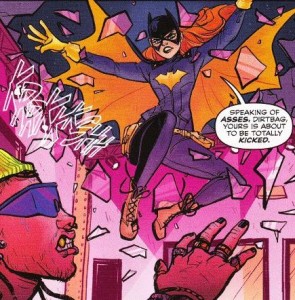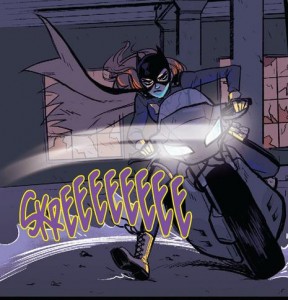As part of our eternal quest to highlight awesome women doing awesome work in comics, I recently interviewed Babs Tarr, the new interior artist on Batgirl and the first woman to serve as an ongoing artist for a Batman-related title. Readers may also be familiar with her fanart and illustrations of hardcore, gorgeous women, such as the Sailor Scouts biker gang, this Catwoman with a sweet sleeve tattoo, and someone I would never mess with under any circumstances.
We talked about Batgirl’s new look, bringing positive change into comics, and more.
 Let’s start with a big question: how does it feel to be the first woman to be a regular artist on a Bat-book?
Let’s start with a big question: how does it feel to be the first woman to be a regular artist on a Bat-book?
What?! That’s amazing! I feel super honored to be a household name and to be part of the Batman legacy, and to be a part of this history that everyone really seems to care about.
A lot of what I’ve seen of your work has been revisionist fanart, like the Sailor Scouts as a biker gang. How did you go from that to working on Batgirl?
The way it works at DC is that the writers pitch a story, and then they pitch artists to draw the story. Cameron Stewart emailed me when he was still pitching the book and asked me if I’d be interested in doing it, so technically DC kind of found me. And I said, “Of course I am, but my style isn’t like anything I’ve ever seen you publish before. If you think that it’s something DC would say yes to, though, then go for it!”
So as soon as DC said yes to Cameron, they started looking down the list of artists they’d collected and whittled it down to me and one other person. Then I got an email from an editor asking me, “We know you’ve never done sequential work before” – because I hadn’t, before Batgirl – “but would you do some test pages for us?” And I said, “Of course! Let me show you what I can do.” And I did a few test pages and showed them to Cameron, and he fixed a little bit of the action scenes because I’m not really used to drawing that type of stuff, and I sent it back – and the next day they offered me the title!
What are the challenges in creating sequential art as opposed to your previous work?
I came from an illustration background, so I can tell a story with one picture, but it’s kind of hard when you have to be a director. I wasn’t sure when you zoom in on a character and when you zoom out, and I was super new to the storytelling aspect of sequential art as a whole. Cameron’s doing layouts and Mr. Miyagi-ing me right now, and I’m waxing on and off. But eventually they’re going to let me do it on my own, and hopefully I’ll just know karate, you know? So we’ll see how it goes.
A lot of your previous work has been what I’d call “reinventive fanart,” like the Sailor Scouts biker gang. In light of that, how does it feel to be working on an established character like Batgirl?
What surprised me the most was that I was doing all the stuff you see here for fun, and DC saw it and liked it enough to pay me to do it full-time. And that’s the goal, right? Before, I was working at an ad company, and I was having to adjust my art style to fit under their umbrella. But DC was just like, “We love what you do! Just do your thing and do it to Batgirl!”
The new Batgirl costume – was that you or Cameron, or both?
Cameron and I collaborated on it. He came up with the costume and then gave it to me, and I added a bunch of details to it, and that’s how we got to where the costume is today.
That costume was probably the most talked-about element of the comic, even before the first issue came out, and everyone seemed to have very strong opinions about it. Were you expecting that kind of reaction?
I was kind of bracing myself for the worst, because I know what the comics community can be like when something changes, and I thought for sure everyone was going to hate us. I mean, I knew the costume was good, but I wasn’t sure about what people were going to think. So the fact that we got this almost unanimous reaction where it was well-received – it’s beyond my greatest expectations. And I think it came at the right time. People were waiting for this; they were hungry for something like what we’re giving them. All the stars aligned just right.
I think the reason a lot of people, including me, like the costume is because it’s functional rather than sexualized. It actually looks like something that you’d wear if you were in your early 20s and fighting crime.
What’s cool about this costume is that Batman didn’t provide it for her. It’s her own. She went out and she bought those clothes; she created it herself. She’s not in his shadow anymore. In our run, we’re trying to establish Batgirl as her own person.
The suit is still sexy, but it’s not sexual or blatantly obscene. It’s sleek, but it’s not sexualizing her in a really gross way. And it’s kind of fashionable, too; you know, she’s a 21-year-old going out. It’s a superhero costume, but with some fashion elements. What could be better than that?
This new take on Batgirl seems like one that a lot of girls and women can really get behind, since the focus is on what she does and not on her perceived sexiness or her body.
Every day we get tweeted at or written to by someone thanking us for what we’re doing. It feels so great to work so hard on something that we feel so passionate about – you pour yourself into this comic and you work so hard – and to know that there are people out there who care just as much as we do.
In addition to your illustration work, you’ve done art for games in the past. What would you say are the differences between creating games art and working in a static medium such as comics or illustration?
When you’re working on a game, it’s a lot of concept art, so nobody has to see it except the designers. It’s like costume design. Working on Batgirl is like costume design and concept work and creating a world and putting it into a story, and then being a director and picking what the panels are going to look like, and then you have to read a script. So it’s really different. Concept art is fast and loose; they just want ideas, so you just draw and draw and pitch things, and nothing ever gets polished or refined.
On the subject of comics art, a 2000AD artist (I can’t remember which one) made a very interesting comment: if you hate drawing something, what you should do is draw it over and over until you don’t hate it as much. What do you really love drawing, and what do you hate drawing?
I really love drawing badass ladies – Dinah’s pout in Batgirl is probably my favorite thing in the whole world to draw – and I hate buildings and backgrounds. But ever since I started working on Batgirl, I’ve had to draw lots of them because she lives in a city. And yeah, I hate them a little less! I think with the things you don’t like to draw, you don’t like them because they’re new or hard or you’re scared, but once you get this language going, it becomes a go-to thing and those things become easier.


